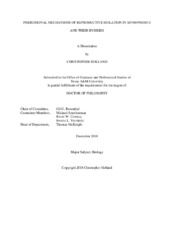| dc.description.abstract | Pheromones play an important role in conspecific mate preference across taxa. While the
mechanisms underlying the pheromonal basis of reproductive isolation are well characterized in
insects, we know far less about the mechanisms underlying the production and reception of
chemical signals in vertebrates. In the genus Xiphophorus, conspecific mate recognition depends
on female perception of male urine-borne pheromones. I focused on interspecific differences
between the sympatric X. birchmanni and X. malinche, which form natural hybrid zones as a
consequence of changes in water chemistry. First, I identify the organ of pheromone production
and compounds comprising chemical signals. I localized pheromone production to the testis;
testis extract elicited the same conspecific preference as signals generated by displaying males. I
used solid phase extraction (SPE) in combination with high performance liquid chromatography
(HPLC)/ mass spectrometry (MS) to characterize pheromone chemical composition. Analyzing
HPLC/MS readouts for pure peaks with high relative intensity identified two compounds of
interest, which were identified according to their fraction pattern and retention times and then
individually assayed for their effect on female behavior. The ability to directly measure the
pheromones with paired responses of female conspecific mate recognition gives insight into what
specific components are important to female mate choice. Elucidating the chemical composition
of Xiphophorus signals sheds light into how communication acts as a reproductive barrier
between species and how its breakdown facilitates hybridization. Next, I characterize
intraspecific variation in pheromone signals. Understanding the relationship between a
quantifiable male pheromone profile and measurable female response provides unique insight
into female mate choice. I examined the variation in male morphology in X. birchmanni, and
used SPE to measure changes in pheromone structure in relation to distinct morphometric traits.
Lastly, I evaluate the relationship of male pheromone phenotype to population substructure. If
pheromones play a role in reproductive isolation, pheromone profiles should map on to male
genotype morphology. Hybrid zones vary from highly structured, with distinct birchmanni-like
and malinche-like subpopulations, to highly admixed hybrid swarms. I measured pheromone
profiles for individual males, I show the relationship between male morphology, pheromone
profile and population structure. | en |


